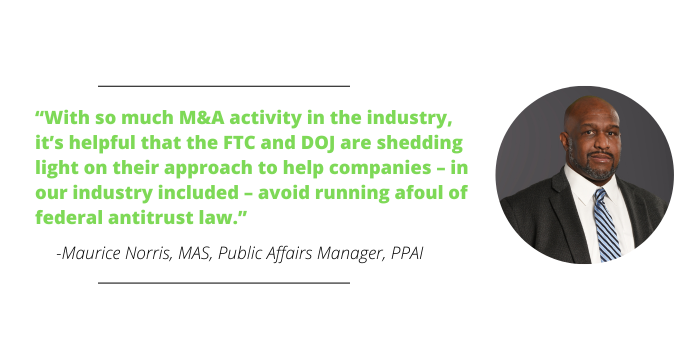Federal M&A Guidelines Get An Update In 2023

The Federal Trade Commission (FTC) and U.S. Department of Justice (DOJ) have finalized and released the 2023 Merger Guidelines, which breaks down the government agencies’ methodology behind reviewing mergers and acquisitions.
Considering the consolidation of the promotional products industry over the past decade, and particularly since the COVID-19 pandemic, it’s important for promo leaders to understand the factors and frameworks that the agencies rely upon when analyzing such deals.
PPAI Public Affairs Manager Maurice Norris, MAS, says re-evaluating M&A review guidance was an early priority of the Biden administration. In fact, the president signed an executive order directing the agencies to develop this guidance just months after taking office.

“With so much M&A activity in the industry, it’s helpful that the FTC and DOJ are shedding light on their approach to help companies – in our industry included – avoid running afoul of federal antitrust law,” Norris says. “It’s also worth noting this is just guidance, not a new regulation. However, the content does clarify how the relevant agencies are enforcing the rules in this space.”
Marketshare Thresholds
The 2023 Merger Guidelines, which has several changes from the draft version released in July, have kept lower thresholds for scrutinizing transactions. According to the finalized version, M&A activity is likely to be challenged if:
- a deal would give the combined firm a more than 30% market share;
- and if a deal reaches a lower concentration threshold than the one identified in the 2010 guidelines the new version replaces.
The 2010 version relies upon the Herfindahl-Hirschman Index (HHI), a commonly accepted measure of market concentration, according to the DOJ. In the new version, if a merger surpasses a score of 1,800 on the HHI (up from 2,500 in the 2010 version), it’s presumed to “substantially lessen competition or tend to create a monopoly.”
RELATED: M&A Best Practices: How To Ensure A Successful Transition
“These finalized guidelines provide transparency into how the Justice Department is protecting the American people from the ways in which unlawful, anticompetitive practices manifest themselves in our modern economy,” says Attorney General Merrick B. Garland. “Since releasing the draft merger guidelines earlier this summer, we have engaged with stakeholders across the country, and the guidelines are stronger as a result.”
‘New Realities’ In Modern Economy
The 2023 Merger Guidelines has shrunk from 13 guidelines in the draft version to 11 in the finalized version.
- The proposed Guideline 13 warning of mergers that could “otherwise substantially lessen competition or tend to create a monopoly” has been replaced with an unnumbered caveat that the guidance “isn't exhaustive” of all the ways mergers can threaten competition.
- The proposed Guideline 6 has integrated into the finalized Guideline 5, which states that “the agencies will examine the extent to which a merger creates a risk that the merged firm will limit rivals’ access; gain or increase access to competitively sensitive information; or deter rivals from investing in the market.”
“Fair, open, competitive markets have been essential to America's dynamic, thriving economy, and policing unlawful mergers is our front line of defense against harmful corporate consolidation,” says FTC Chair Lina M. Khan. “The 2023 merger guidelines reflect the new realities of how firms do business in the modern economy and ensure fidelity to statutory text and precedent.”

